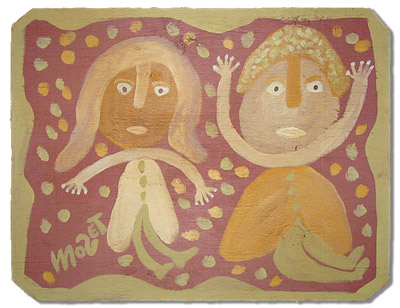Jury Apparently Unconvinced of Sky Color

Birmingham (JM) - The jury is still out on what color the sky is, and hope for a decisive verdict dwindles by the hour. As deliberations linger into a third day, the specter of a mistrial casts an ominous shadow over the courtroom of United States District Judge Karon Bowdre.
U. S. Attorney Alice Martin concluded her arguments Monday morning in the natural-law trial of Mose Tolliver, a disabled folk artist from the Montgomery area. Tolliver, who often uses the alias 'Mose T.' is accused of multiple counts of violating natural law by depicting skies of white, gray, pink, magenta, orange, violet, green and ochre in his numerous folk-art paintings, instead of the more accepted shades of azure blue.
The 'Sky Blue - Ox Brown' act was passed just a year ago specifically to protect schoolchildren and other Alabamians from conflicting messages about nature that might be disseminated by 'outsider artists' or 'abstract expressionists'. Tolliver, whose paintings have been exhibited in museums nationwide, and reproduced in children's literature, is the first to be charged under the new law.
The prosecution, headed by Martin, brought in several expert witnesses from the world of atmospheric research and optics to explain how a broad spectrum of electromagnetic 'waves' with different 'frequencies' is transmitted through the stratosphere and dispersed there by suspended particles of 'water vapor' which, due to a process called 'Rayleigh scattering' absorbs certain wavelengths of this radiation, allowing others to be transmitted and dispersed. Upon entering the human eye, it was argued, these selectively dispersed frequencies are focussed on the 'retina' where small receptors consisting of 'rods and cones' discriminate the 'frequency' and excite the brain's electrochemical structure in patterns which are interpreted as 'blue'. "Blue," argued Martin, is that range of dispersed waves with frequencies of between 420 and 490 nanometers.
Tolliver, representing himself, limped to the stand Friday and began leafing through a stack of recent panels, all executed in housepaint. A bailiff silently held each one up for the jury's examination. One depicted a large winged dragon in dark green sailing across a pink sky studded with asymmetrical stars. Another was a self-portrait of Tolliver with his crutches, gazing upward into a stark white sky with pale green streamers weaving around his head. The jury at several points revealed apparent pleasure as each painting was displayed, especially after sitting through two days of testimony on optics and neurochemistry.
Since retiring to deliberate, notes passed from the jury room to Bowdre have asked about the possibility of taking a brief outdoor recess during daylight hours "just to look". The request was denied. A confidential memo leaked to the press revealed that Tolliver had expressed his intention of letting the paintings speak for themselves before the trial even began. It further revealed that Tolliver feared that if former prosecutor Michael Rasmussen were trying the case, that he might have just opened the blinds in the courtroom and gestured out the window as his closing argument - A tactic that Tolliver would have had difficulty countering.
Commentators have expressed guarded optimism that color will not be a factor in the verdict.





